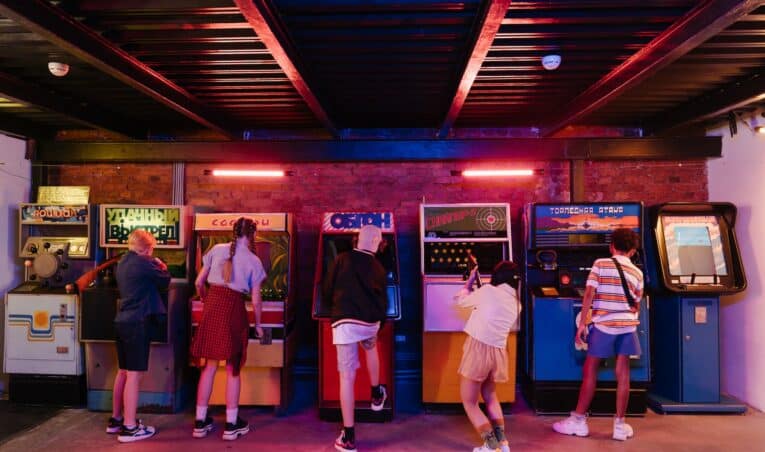
The Early Days: Pinball and Arcade Cabinets
In the early 20th century, the concept of a virtual reality arcade was still a figment of the imagination, and pinball machines reigned supreme. They were a fixture in bars, amusement arcades, and social venues across the nation. Pinball was not just a game but a cultural phenomenon that transcended generations. What began as a simple form of entertainment, manipulating steel balls inside a glass-covered cabinet, evolved into a competitive scene with leagues and tournaments. Even celebrities like Elvis Presley were photographed playing pinball. Despite legal controversies and technological limitations, pinball laid the foundation for the gaming culture that we know today.
The Golden Age: 1970s and 1980s
The 1970s and 1980s brought a sea change to the gaming world with the introduction of arcade cabinets. Titles like “Pac-Man,” “Space Invaders,” and “Donkey Kong” transformed the way people played games. Arcades became centers of innovation, with developers pushing boundaries in graphics, sound, and gameplay. Long lines of players eagerly awaited their turn, feeding quarters into machines, hoping to beat the highest score. This era saw not only the birth of iconic characters but the forging of a community around the shared passion for gaming. Arcades were bustling centers of social interaction, far from the solo experience in the virtual reality arcade today.
The Advent of Home Consoles
With the arrival of home consoles, the arcade scene witnessed a significant shift. Systems like the Atari 2600, Nintendo Entertainment System, and Sega Genesis meant that players no longer had to leave their homes for a high-quality gaming experience. Gaming magazines, TV shows, and even movies started reflecting this trend, showcasing the ‘coolness’ of home gaming. The influence reached further, affecting how games were designed, with an emphasis on longer, more complex narratives and characters. Although convenient, home gaming could not replicate the arcade’s community feel, marking a decline in traditional arcades and paving the way for new innovations like the virtual reality arcade.
The Resurgence of Arcades: The Role of Virtual Reality Arcade
Fast forward to the present, and we find a resurgence in arcades driven by Virtual Reality (VR) technology. The emergence of the virtual reality arcade signals a revolutionary phase, marrying technology with the communal aspect of gaming. Adventure Vault, leading the way, offers an array of VR experiences for all ages. Schools and educational institutions are exploring VR arcades for educational purposes, enhancing learning through immersive experiences. The virtual reality arcade transcends simple gaming, becoming a space for creative exploration, training, and even therapy. Virtual reality is not merely a technological advancement; it’s a new frontier in human interaction and expression.
The Social Aspect of VR Arcades
One of the most compelling aspects of the virtual reality arcade is the rekindling of the social essence of gaming. Adventure Vault, among others, offers multiplayer experiences, allowing friends and family to connect in ways that were unimaginable a decade ago. Community events, VR tournaments, and social gatherings centered around VR arcades are on the rise. Gamers of all backgrounds come together, forming connections beyond the virtual world. The virtual reality arcade serves as a melting pot of cultures, ages, and interests, becoming a hub of creativity, competition, and camaraderie.
The Future of Arcades: Virtual Reality Arcade and Beyond
The future of the virtual reality arcade is bright and expansive. As technology advances, new horizons are opening in gaming, education, business, and art. Developments in haptic feedback, motion tracking, and artificial intelligence are paving the way for unprecedented immersive experiences. The virtual reality arcade is becoming a testbed for innovation, with researchers exploring its potential in rehabilitation, mental health, and even architectural visualization. As we move forward, the virtual reality arcade will not only be a space for entertainment but a platform for exploration, growth, and discovery. It will become an integral part of our daily lives, transcending the traditional boundaries of what an arcade used to be.
The journey from pinball to the virtual reality arcade is a reflection of human creativity, innovation, and the relentless pursuit of immersive experiences. It showcases our ability to blend technology, art, and community. Whether reliving the glory days of pinball, reminiscing about the golden era of arcade cabinets, or stepping into the thrilling worlds of VR, the arcade’s legacy endures, continuing to inspire, entertain, and connect us. The virtual reality arcade is not just a gaming trend; it’s a gateway to the future, promising an extraordinary voyage into the limitless potential of human imagination.

